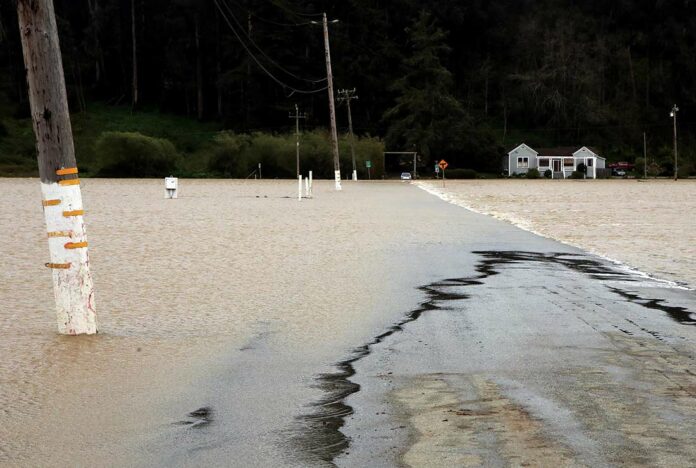
PAJARO—With hundreds of acres of farmland still underwater Thursday, farmers are unsure how the recent flood will affect their businesses. At the same time, employees are unable to return to work, and many who were evacuated are still unsure if they will have a home to return to when the waters ebb.
Dick Peixoto, who owns Lakeside Organic Gardens, reckons that 20 acres of his farmlands were covered, amounting to about a 5% loss in his organic vegetable production this season.
Worse, business took a hit because many workers were unsure how to get to work because of road closures and flooding.
Nishan Moutafian, Driscoll’s Berries Vice President of Production for the U.S. Baja and Canada, said that some 1,500 acres were underwater, representing tens of millions of dollars of investment by growers, leaving in question whether they can be used this year.
“I feel so much for the community and all the people that have been affected,” he said. “Our growers are an important part of this community, and have been for such a long time.”
While Moutafian expects that most of those fields will be salvageable, some will not.
“There will be individual growers whose fields and businesses are devastated by this flood,” he said.
Strawberry growers in this area plant once a year, so for the most impacted fields, they will lose their crops for this season.
Moutafian says that Driscoll’s has donated $90,000 to local organizations involved in relief efforts.
“This is a time for everyone to come together and do everything we can do,” he said. “There is going to be so much recovery work ahead for this community and for the growers impacted that way, that will be a part of this community’s recovery.”
California Strawberry Commission spokesman Jeff Cardinale said that strawberries that were under production in Watsonville are “probably a total loss,” but that the width and breadth of damage will not be known until the waters recede.
But the biggest concern, he said, is the people directly impacted by the flood.
“The town of Pajaro is devastated,” he said. “There are 2,000-3,000 people who have been evacuated, and they don’t know what they will find when they go home.”
The good news, he said, is that production was already underway in Santa Maria and Oxnard, and within the next few weeks those areas can increase production to reach the three-year average levels by April. That means that the fruit will stay on grocery store shelves.
If a farm is eroded by running water, it can mean damaged or destroyed equipment and property, along with topsoil loss.
If the water brought sediment with it, debris can partially or completely bury the plants. If the sediment is contaminated, it can mean the crop is unusable.
Monterey County officials expect much higher damage estimates this time around to its $4.1 billion agriculture industry compared to the storms from earlier this year.
Norm Groot, executive director of the Monterey County Farm Bureau, said the earlier damage estimates, released in February, found that more than 15,000 acres of lettuce, strawberries, wine grapes and other crops were destroyed in the storms that kicked off 2023, mostly in southern Monterey County. Estimated damages and future losses totaled $336 million, according to a survey by the Monterey County Agricultural Commissioner’s Office.
However, areas that were spared from major flooding in January, primarily Pajaro, are now underwater, which is expected to drive up the damage numbers even higher. The Salinas Valley also experienced more devastating floods than in January, Groot noted.
“The Pajaro Valley has many acres currently underwater,” he said. “This poses a serious threat to the entire spring season. With the fields being so saturated and inaccessible, planting schedules in March will probably be delayed.”
Monterey County Agricultural Commissioner Juan Hidalgo said assessing the damage “is going to be a long process.”
“Some of the damage we’ve seen is quite alarming,” he said. “The Pajaro area was not quite as impacted in January as it is right now. This is definitely something that’s going to set some of our growers back.”
Hidalgo said Pajaro’s strawberry and raspberry fields were planted in the fall and slated for production in the spring. These plants, he noted, can survive underwater for some time, but for how much longer they can last is unknown, as there is no estimate for when the floodwaters will fully recede.
Based on previous experience, growers could be seeing anywhere from 30%-50% less yields this season, Hidalgo said.
Groot said once the floodwaters recede, growers will have to undergo a 30- to 60-day process to test soils, irrigation and other equipment for contaminants left behind, as required by the food safety practices of the California Leafy Greens Handler Marketing Agreement.










